Do you have a question about the Top Flite P-40 Warhawk and is the answer not in the manual?
Details the manufacturer's guarantee against defects and liability limits.
Emphasizes the model is not a toy and requires careful handling.
Stresses the importance of following instructions for safety.
Highlights the need for straight, true, and strong construction.
Underscores correct installation and pre-flight checks of all parts.
Details radio channel requirements and servo configurations.
Specifies suitable servos based on torque requirements.
Explains the numbering system for screws used in the kit.
Defines the procedure for checking part fit before gluing.
Emphasizes the critical nature of correct landing gear block installation.
Directs users to follow steps for fixed landing gear.
Details identifying and placing the correct landing gear blocks.
Guides on installing blocks into the right wing panel opening.
Explains mounting the aluminum/fiber landing gear mount.
Advises double-checking all landing gear block installations.
Highlights the importance of correct block installation for retractable gear.
Guides on identifying and placing blocks for retractable gear.
Details installing blocks into the right wing panel for retracts.
Explains mounting the landing gear and blocks for retracts.
Advises double-checking block installations for smooth gear movement.
Guides on cutting metal pushrods to the specified length.
Details threading nuts, clevises, and retainers onto pushrods.
Introduces instructions for engine, muffler, radio, and servo installation.
Explains engine mounting bolt patterns on the firewall.
Guides on using plywood spacers for engine spacing.
Details installing engine mounting bolts and washers.
Explains marking and drilling firewall holes for lines.
Guides on installing fuel lines onto brass tubes from the fuel tank.
Details installing the fuel tank into the fuselage.
Explains routing the carburetor line through the firewall.
Guides on drilling holes for fuel lines and installing the fuel plug.
Explains mounting the throttle servo and making a former opening.
Details installing the battery and receiver onto the tray.
Explains installing the radio switch and charge jack.
Details engine stand-off mounting and control linkage setup.
Guides on mounting the chosen muffler to the engine.
Details locating and mounting the plywood ignition module/battery tray.
Details making connections for the ignition switch.
Guides on sliding the cowl over the engine and making necessary cutouts.
Details positioning the cowl and drilling mounting holes.
Verifies proper operation and centering of control surfaces.
Explains setting control surface throws for optimal flight.
Explains measuring elevator up and down throw.
Provides recommended throw settings for control surfaces.
Emphasizes the CG's critical effect on flight success.
Guides on setting up for CG measurement using a machine or marks.
Details the procedure for balancing the model at the CG point.
Explains identifying and correcting tail-heavy conditions.
Stresses rechecking CG after adding weight.
Explains how to adjust weight for lateral balance.
Stresses the importance of model identification for safety.
Provides instructions for charging transmitter and receiver batteries.
Warns about initial battery conditioning for full capacity.
Guides on running the engine and inspecting the model.
Warns about severe injury risks from engine safety failures.
Advises on safe storage and handling of engine fuel.
Warns about propeller throwing debris.
Stresses the need for safety glasses when running engines.
Advises keeping body and spectators away from the propeller.
Lists items to keep away from the propeller.
Emphasizes securing the glow plug clip.
Guides on making engine adjustments safely.
Details running the engine to ensure proper idling and transitions.
Warns about the engine becoming hot after operation.
Explains the correct method for stopping a gasoline engine.
Covers airworthiness, altitude, site rules, and identification.
Covers ground checks, spectators, frequencies, and model handling.
Explains the checklist's role in ensuring proper pre-flight preparation.
Advises fuelproofing areas exposed to fuel or exhaust.
Reminds to check the model's Center of Gravity.
Stresses secure mounting of batteries and receivers.
Recommends checking lateral balance as explained.
Confirms control direction and throws are set correctly.
Advises checking clevis retainers and servo arm screws.
Notes the P-40 is not a trainer and requires experienced pilots.
Advises richening mixture for cowled engines to prevent overheating.
Alerts to potential control surface flutter and its causes.
Explains how to identify and address control surface flutter.
Advises practicing ground handling before takeoff.
Guides on applying throttle smoothly during takeoff.
Recommends a cautious approach for initial flights.
Guides on initiating a landing approach by reducing throttle.
Encourages staying in control and flying safely.
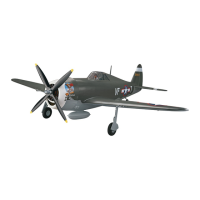


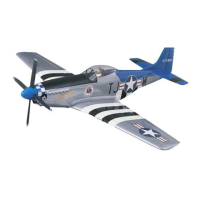

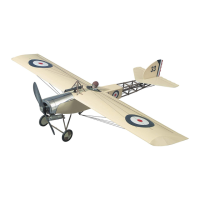
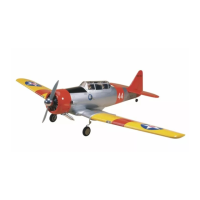
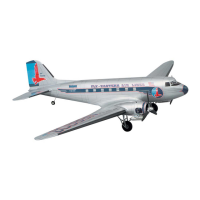
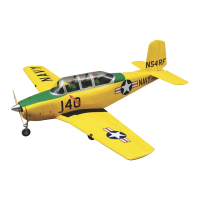

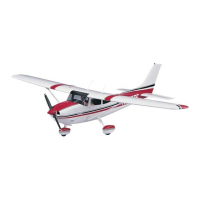
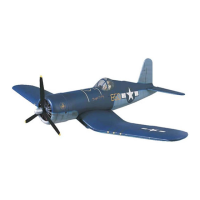
